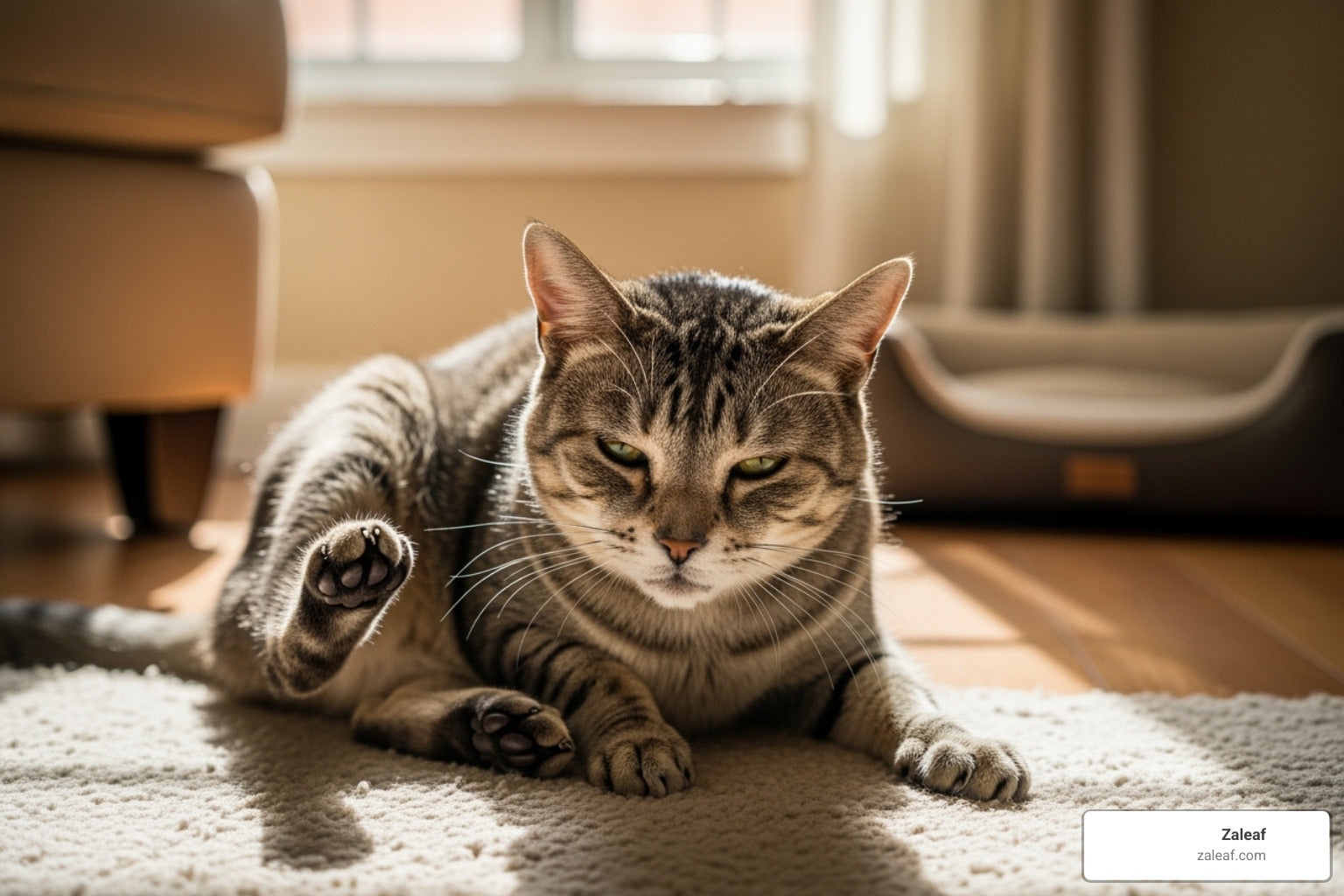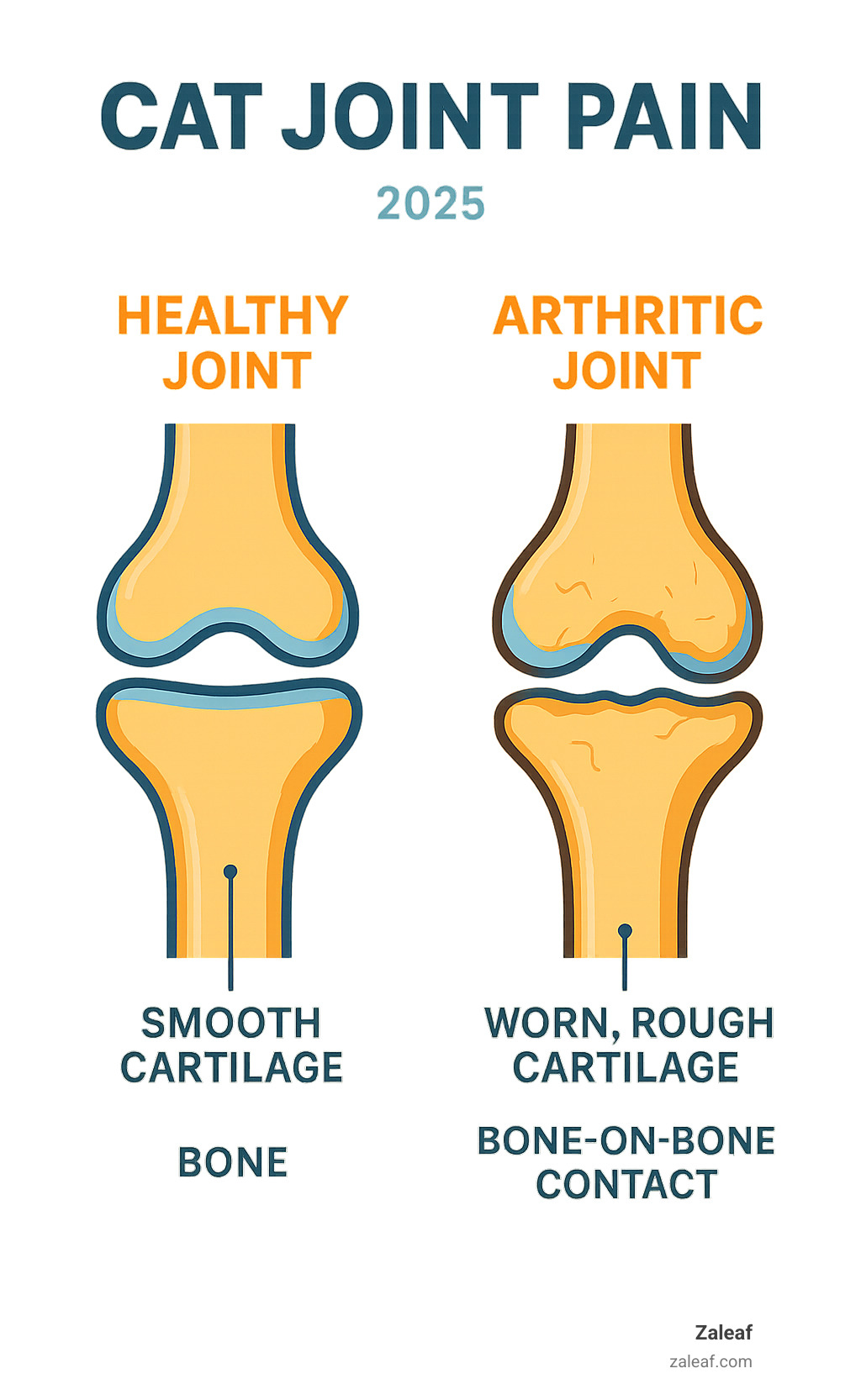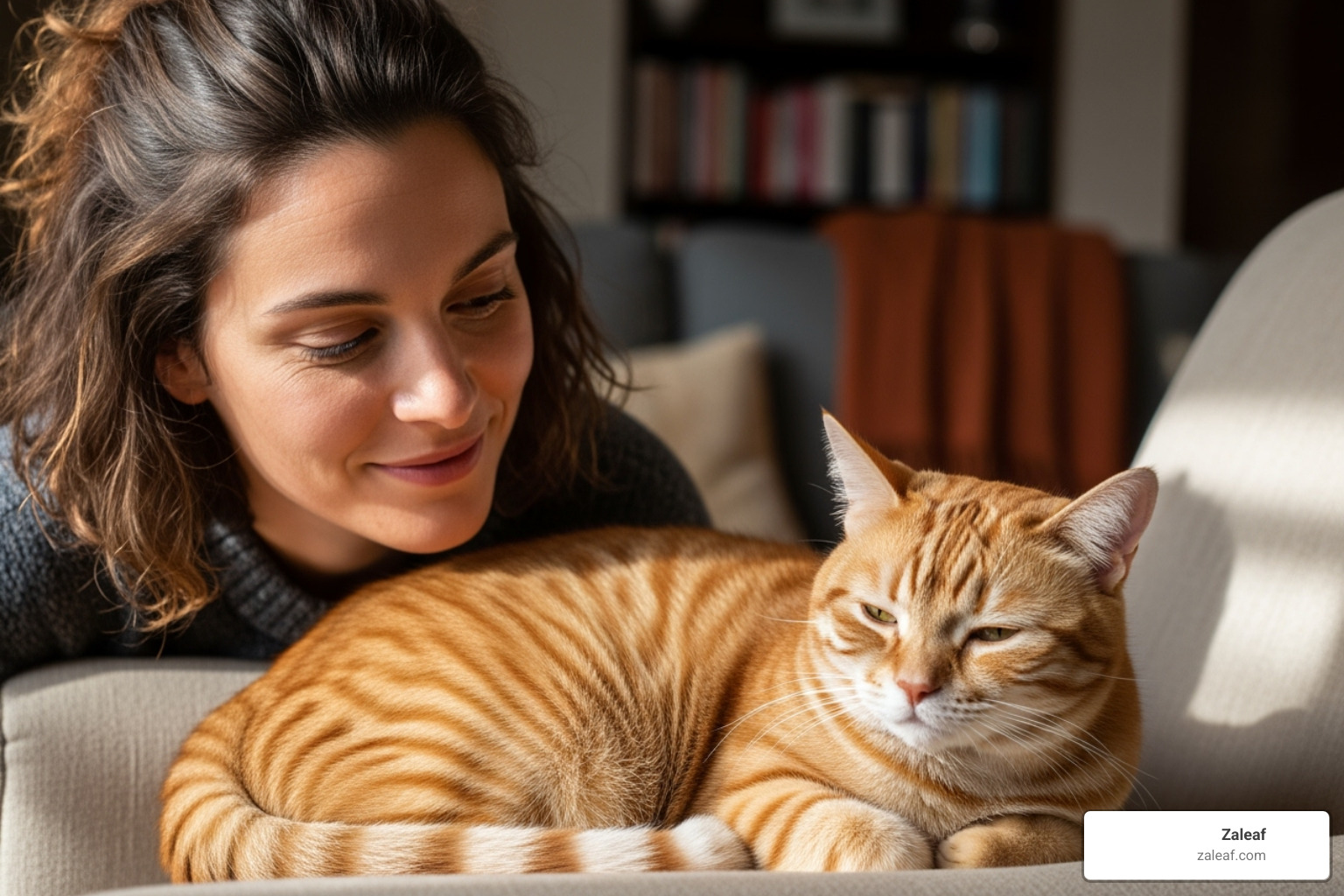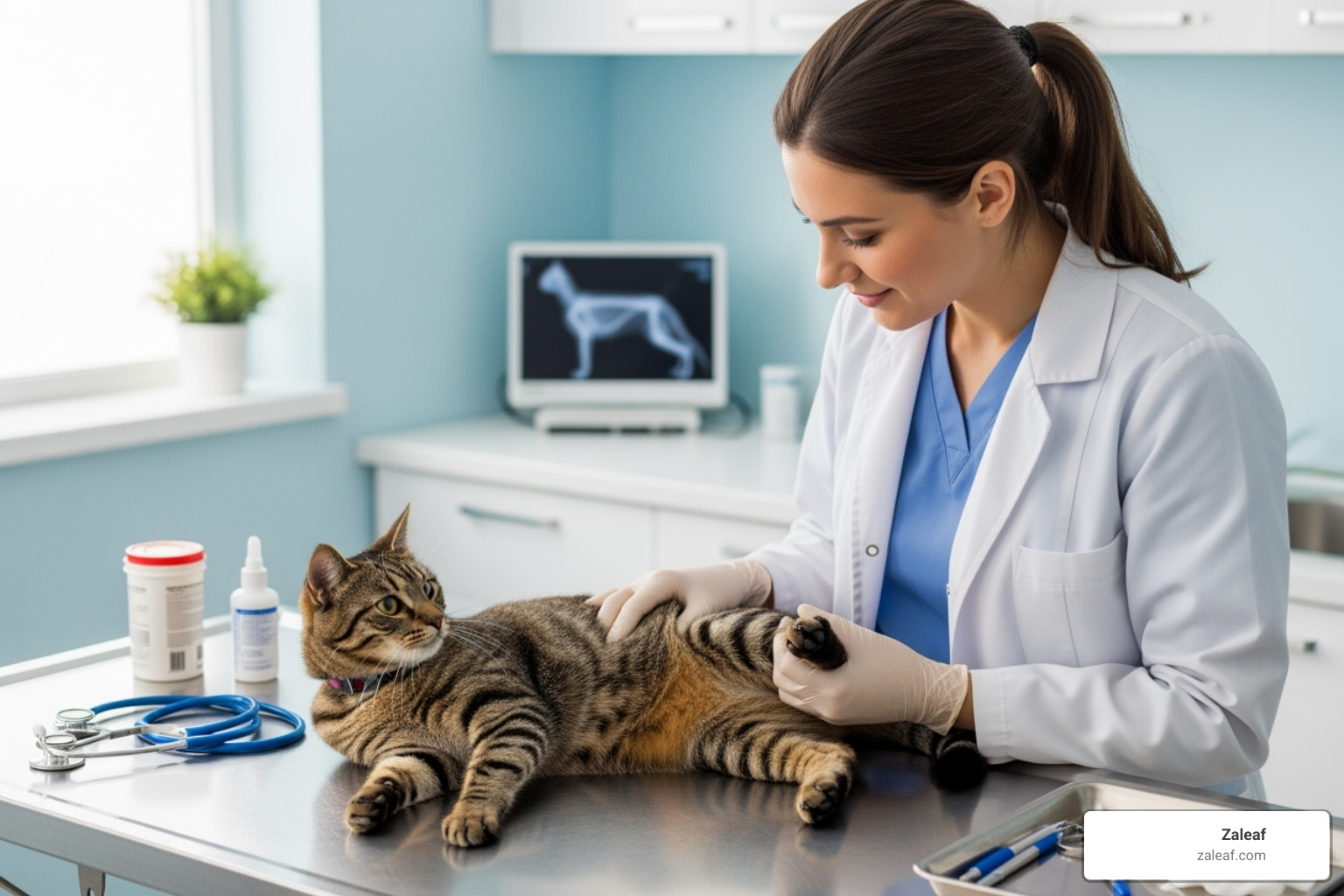Feline Arthritis: A Comprehensive Guide to Your Cat's Mobility

Understanding the Reality of Feline Joint Discomfort
Cat joint pain affects the vast majority of our feline companions as they age, with studies showing that approximately 90% of cats over 10 years old experience osteoarthritis in at least one joint. Yet this common condition often goes unnoticed because cats are masters at hiding their discomfort.
Quick Answer for Cat Joint Pain:
- What it is: Degenerative joint disease where cartilage wears down, causing bones to rub together
- Key signs: Reluctance to jump, stiffness after rest, reduced grooming, litter box issues
- Most affected: Cats over 6 years old (60% show signs), nearly universal in senior cats
- Treatment: Veterinary care, pain management, environmental modifications, natural supplements
- Prognosis: Manageable condition that doesn't shorten lifespan with proper care
Unlike dogs who might limp or whine when joints hurt, cats simply avoid activities that cause pain. They stop jumping onto counters, sleep in easier-to-reach spots, and gradually become less active. This survival instinct makes early detection challenging but crucial for maintaining their quality of life.
The condition involves the smooth cartilage that cushions joints wearing away over time. As one researcher noted, this creates surfaces that grind against each other "like sandpaper" - causing inflammation, pain, and reduced mobility in the shoulders, hips, elbows, knees, and spine.
I'm Max Shemesh from Zaleaf, and through years of working with pet owners seeking natural wellness solutions, I've seen how cat joint pain significantly impacts both cats and their families. My experience in the cannabinoid industry has shown me the importance of combining professional veterinary care with thoughtful, natural support options for our feline friends.

Recognizing the Subtle Signs of Feline Arthritis
Our feline friends are incredibly skilled at hiding pain - it's a survival instinct that kept their wild ancestors safe. This natural ability makes spotting cat joint pain feel like being a detective in your own home. Unlike dogs who might yelp or limp obviously, cats simply avoid activities that hurt.
Think about it this way: your cat won't necessarily miss that jump onto the kitchen counter. They'll just stop trying altogether. Research shows that while fewer than half of arthritic cats actually limp, nearly three-quarters refuse to jump, and two-thirds jump much shorter distances than before.
These "absence symptoms" - behaviors that quietly disappear - are much trickier to notice than obvious signs of pain. But once you know what to look for, the clues become clearer. The American College of Veterinary Surgeons provides excellent resources on understanding feline osteoarthritis, and their research confirms that cat joint pain affects the vast majority of senior cats.
Key Symptoms of Cat Joint Pain
Reluctance to jump or climb tops the list of warning signs. Your once-athletic cat might hesitate before leaping onto their favorite perch, or you'll notice those telltale "false starts" where they crouch but don't follow through. Some cats start using their front legs to pull themselves up when their hips ache.
Hesitation on stairs becomes obvious when your cat takes each step slowly, bringing both back legs together instead of their usual fluid movement. Many cats simply start avoiding stairs entirely, which might mean relocating their favorite sleeping spots to ground level.
Stiffness after rest shows up most clearly when your cat first wakes from a long nap. They might move like an old person getting out of bed, taking a moment to "warm up" their joints before moving normally.
Reduced activity and play often gets dismissed as "just getting older," but it's frequently pain talking. Your playful hunter might lose interest in toys, spend more time hiding, or sleep significantly more than usual.
Decreased grooming happens because reaching certain spots - especially around the back and hips - becomes too painful. You'll notice a less pristine coat, particularly around areas they can't comfortably reach.
Overgrown claws develop when cats can't use their scratching posts properly or stay active enough to naturally wear down their nails. Left unchecked, these can curve into paw pads and create additional pain.
Irritability when petted might be the first sign many owners notice. Your usually affectionate cat might suddenly flinch, growl, or swat when touched in tender areas. They're not being mean - they're protecting themselves from pain.
Urinating outside the litter box often gets blamed on behavioral issues, but climbing into the box or holding a squatting position can be genuinely painful for arthritic cats. Sometimes switching to a litter box with lower sides solves the problem entirely.
When to Consult a Veterinarian
Any combination of these subtle signs warrants a conversation with your veterinarian. Cats are professional pain-hiders, so by the time you notice obvious symptoms, their cat joint pain might be quite advanced. Early diagnosis opens up more treatment options and can significantly improve your cat's comfort.
Here's a pro tip from veterinarians: record videos of your cat at home, especially when they're struggling with activities like jumping or using stairs. Cats have an uncanny ability to "perform" perfectly at the vet's office, making diagnosis challenging. Your home videos provide invaluable evidence of what's really happening day-to-day.
Professional assessment becomes crucial because what looks like normal aging might actually be manageable pain. Your veterinarian can distinguish between the two and help create a plan to keep your feline friend comfortable and mobile.

What Causes Joint Pain in Cats?
Cat joint pain typically develops through osteoarthritis (OA), a condition where the smooth cartilage protecting your cat's joints gradually breaks down. Think of cartilage as nature's shock absorber - when it wears away, bones start grinding against each other like sandpaper. This creates the inflammation and discomfort that makes jumping onto the couch feel like climbing Mount Everest for your feline friend.
The most common culprit is simply wear and tear over time. Just like the tread on your favorite sneakers eventually wears thin, your cat's joint cartilage naturally degrades with age and use. However, this isn't just an inevitable part of getting older - several factors can speed up this process significantly.
Genetics play a surprisingly big role in joint health. Some cat breeds seem to have drawn the short straw when it comes to joint problems. Maine Coons, Siamese cats, and Scottish Folds are more likely to develop conditions like hip dysplasia or other joint abnormalities that can lead to early arthritis. It's like some cats are born with joints that don't quite fit together perfectly, causing extra wear over time.
Previous injuries can also set the stage for future joint problems. That time your adventurous cat misjudged a jump and landed awkwardly? Even if they seemed fine afterward, injuries like fractures or ligament damage can create weak spots that develop into arthritis years later. Sometimes it's not one big injury but countless small ones - all those daily leaps from counter to floor add up over a lifetime.
Obesity deserves special mention because it's both preventable and incredibly damaging to joints. While extra weight doesn't directly cause arthritis, it absolutely makes existing cat joint pain worse. Every extra pound puts additional stress on already struggling joints, and obesity creates inflammation throughout the body that can accelerate joint breakdown.
Can Cat Arthritis Be Prevented?
While we can't change your cat's genetics or turn back the clock, we can definitely stack the deck in their favor. The good news is that many of the most effective prevention strategies are also the simplest.
Weight management tops the list by a mile. Keeping your cat at a healthy weight throughout their life is like giving their joints a daily gift. For growing kittens, this means encouraging steady, gradual growth rather than rapid weight gain that puts extra stress on developing joints.
A healthy diet rich in nutrients supports overall joint health. Many veterinarians recommend foods with natural omega-3 fatty acids, which help fight inflammation before it becomes a problem. Think of good nutrition as maintenance for your cat's internal machinery.
Regular, gentle play keeps the muscles around joints strong and supportive. You don't need to turn your cat into an athlete - consistent, low-impact activities work best. Interactive toys that encourage movement without high-impact jumping are perfect for this.
Avoiding trauma might seem obvious, but creating a safe environment really matters. This could mean adding ramps to high surfaces or ensuring your cat has secure footing on their favorite perches.
According to Cornell Feline Health Center research, an astounding 90% of cats over 12 show signs of arthritis on X-rays. While this statistic might seem discouraging, it actually highlights how normal joint changes are - and how much difference proper management can make in your cat's comfort and quality of life.
Veterinary Care and Professional Treatment Options
When you suspect your feline friend is dealing with cat joint pain, scheduling a veterinary consultation becomes your most important next step. Your veterinarian will become your partner in helping your cat feel comfortable again, starting with a thorough physical examination that carefully assesses each joint.
During this exam, your vet will gently palpate your cat's joints, checking for swelling, heat, or pain responses. They'll assess your cat's range of motion and listen for crepitus - that telltale grating sound that occurs when cartilage has worn away and bones rub together. Don't be surprised if your cat seems perfectly fine at the clinic - they're masters at putting on a brave face when stressed!
This is exactly why those home videos I mentioned earlier are so valuable. Your observations of daily behaviors - like hesitating before jumping or moving stiffly after naps - provide crucial diagnostic clues that complement the physical exam.
X-rays often help confirm the diagnosis, though interestingly, cats with osteoarthritis may show less dramatic changes on X-rays compared to dogs. Sometimes your vet might even suggest a treatment trial with pain medication to see if your cat's mobility improves - this can actually help confirm that joint pain was the culprit.

The good news is that modern veterinary medicine takes a multimodal approach to treating cat joint pain. This means combining several different strategies to achieve the best possible outcome for your furry friend. The goal isn't just managing pain - it's about reducing inflammation, slowing disease progression, and most importantly, helping your cat enjoy life again.
Pain management medications form the cornerstone of treatment. NSAIDs like meloxicam work wonderfully to reduce both pain and inflammation. However, long-term use requires careful monitoring since cats process these medications differently than dogs or humans. Your vet might also prescribe Gabapentin for nerve-related pain or Amantadine as an additional pain reliever.
Injectable joint protectants offer another powerful tool. Polysulfated glycosaminoglycan helps protect cartilage by stopping destructive enzymes, though it's used off-label in cats. A newer option is a monoclonal antibody injection specifically approved for cats that works by blocking pain signals at their source.
Supportive Approaches for Cat Joint Pain
Beyond medications, your veterinarian will guide you through several supportive strategies that work together beautifully. Weight management remains absolutely critical - even losing just a pound can significantly reduce joint stress in cats. Your vet can help create a safe weight loss plan if needed.
Physical rehabilitation might sound fancy, but it's often as simple as gentle stretching exercises or encouraging controlled movement. Some cats even benefit from hydrotherapy, though this definitely requires a water-loving personality!
The beauty of working closely with your veterinarian lies in their ability to monitor your cat's comfort levels and adjust treatments as needed. They'll help you recognize signs of improvement and ensure any medications remain safe for long-term use.
Complementary and Holistic Therapies
Many veterinarians now accept complementary therapies that work alongside conventional treatments. Acupuncture has gained tremendous respect in veterinary medicine, with many cats tolerating the thin needles surprisingly well. The ancient practice helps reduce pain and promote natural healing.
Cold laser therapy (photobiomodulation) offers a completely non-invasive option that uses therapeutic light waves to reduce inflammation at the cellular level. Most cats find these treatments quite relaxing - some even purr through their sessions!
Natural supplements play an increasingly important role in comprehensive joint care. These nutraceuticals provide targeted nutritional support that can complement your vet's prescribed treatments beautifully.
The prognosis for cats with properly managed arthritis is genuinely encouraging. While we can't reverse the condition, cat joint pain is absolutely manageable with the right combination of professional care and home support. Most cats maintain their normal life expectancy and return to enjoying their favorite activities - they might just need a little extra help getting there.
Managing Cat Joint Pain at Home
Creating a comfortable, supportive home environment can work wonders for a cat experiencing cat joint pain. Think of it as becoming your feline's personal interior designer – one who understands that every jump avoided is a moment of pain prevented. These thoughtful modifications don't just reduce discomfort; they can genuinely transform your cat's daily experience from one of cautious navigation to confident movement.
The beauty of home management lies in its immediate impact. While medications take time to work and vet visits require scheduling, environmental changes provide instant relief. Your arthritic cat will often show appreciation for these modifications within days, sometimes even hours.
Environmental Modifications for Comfort
The key to successful home modifications is thinking like a cat with sore joints. Every surface they need to reach, every step they take, and every position they rest in becomes an opportunity to either ease or aggravate their discomfort.
Soft, warm bedding becomes essential when joints ache. Orthopedic beds designed for pets provide extra cushioning that supports painful joints, while warming beds can soothe stiff muscles – especially helpful for cats who seek out sunny spots. Just remember to avoid human heating pads, which can become dangerously hot for our feline friends.
Ramps or pet stairs are game-changers for cats who love high perches but struggle with jumping. Place these next to favorite liftd spots like couches, beds, or sunny window sills. Many cats initially seem skeptical of these additions, but once they find the ease of use, they become devoted fans.
Accessible litter boxes often require the most creativity. Look for boxes with at least one low side – you can even create a custom solution by cutting a low entrance in a large plastic storage bin. If your home has multiple floors, placing litter boxes on each level your cat frequents eliminates painful stair climbing when nature calls.
Raised food and water bowls prevent the uncomfortable bending that strains neck and back joints. Elevating dishes to roughly elbow height makes mealtime much more comfortable. Some cats are particular about changes, so introduce raised bowls gradually if your cat seems hesitant.
Non-slip flooring gives arthritic cats confidence in their footing. Strategic placement of rugs, carpet runners, or non-slip mats on slippery surfaces like hardwood or tile can prevent dangerous falls and give your cat the traction they need to move comfortably.
Beyond these physical modifications, consider that cats with cat joint pain may need grooming assistance. Regular gentle brushing prevents matting, especially in areas they can no longer reach comfortably. Don't forget to trim their claws regularly – reduced activity often means less natural claw wear.

Natural Supplements and Dietary Support
While environmental changes provide immediate comfort, natural supplements and dietary support work behind the scenes to address cat joint pain at its source. These approaches complement veterinary care beautifully, offering gentle, long-term support for joint health.
Weight control remains the single most powerful tool in your arsenal against arthritis progression. Even losing just a few ounces can dramatically reduce joint stress in cats. Your veterinarian can help calculate the right caloric intake, but the results often speak for themselves – many cats become noticeably more active and comfortable as excess weight comes off.
Omega-3 fatty acids from high-quality fish oils work as nature's anti-inflammatory agents. These powerful compounds help reduce the inflammation that drives joint pain. Look for pet-specific omega-3 supplements to ensure purity and proper dosing – your cat's joints will thank you for the investment.
Glucosamine and chondroitin supplements support the building blocks of healthy cartilage. While they can't reverse existing damage, they may help slow further breakdown and support overall joint function. Many veterinarians have favorite brands they trust for safety and effectiveness.
Cannabidiol (CBD) from Zaleaf represents an exciting frontier in natural wellness support for cats with joint discomfort. CBD works with your cat's endocannabinoid system, which helps regulate pain, inflammation, and overall comfort. At Zaleaf, we understand that pet parents want the highest quality for their beloved companions – that's why all our products undergo rigorous 3rd party testing for purity and potency.
What makes CBD particularly appealing is its gentle, natural approach to supporting comfort and mobility. Unlike some medications that can stress internal organs with long-term use, CBD offers a more holistic path to wellness. However, it's crucial to distinguish CBD from THC compounds like Delta 8, which haven't been extensively studied in cats and may pose risks.
As with any supplement, introducing CBD should always involve your veterinarian's guidance. They can help determine if it's appropriate for your cat's specific needs and ensure it won't interfere with other treatments. The goal is creating a comprehensive support system where every element – from environmental modifications to natural supplements – works together to give your cat the comfortable, active life they deserve.
Frequently Asked Questions about Feline Arthritis
As pet parents, we naturally have questions when our beloved cats face cat joint pain. These concerns often keep us up at night, wondering if we're doing enough or making the right choices. Let me address the most common questions I hear from worried cat owners, based on my experience at Zaleaf and the countless conversations I've had with families navigating this journey.
How long can a cat live with arthritis?
Here's the reassuring news: cat joint pain from arthritis doesn't shorten your feline friend's lifespan. With thoughtful management and proper care, arthritic cats can live just as long as their pain-free counterparts - often well into their teens or even early twenties.
The key lies in focusing on quality rather than just quantity of life. When we effectively manage their pain and keep them comfortable, cats with arthritis continue to purr, play (albeit more gently), and enjoy their favorite sunny spots. They might not leap onto the kitchen counter anymore, but they'll still greet you at the door and curl up on your lap.
I've seen countless senior cats thrive for years after their arthritis diagnosis, simply because their families committed to a comprehensive care plan that included veterinary treatment, environmental modifications, and natural support options.
What is the best food for a cat with arthritis?
The most impactful dietary change you can make is helping your cat achieve and maintain a lean body weight. Even losing just half a pound can dramatically reduce the strain on painful joints - imagine carrying a heavy backpack all day, then finally taking it off.
Beyond weight management, look for foods rich in omega-3 fatty acids from natural sources like fish oil. These powerful compounds work like nature's anti-inflammatory medicine, helping to reduce joint inflammation from the inside out. Many premium cat foods now include these beneficial fats, or your veterinarian might recommend a specific therapeutic diet.
Your vet may also suggest specialized diets formulated for joint health, which often contain natural ingredients like glucosamine and chondroitin. These diets are designed to support cartilage health while providing complete nutrition. Any dietary changes should be made gradually over 7-10 days to avoid digestive upset.
Can I give my cat human pain relievers for arthritis?
Absolutely not. This cannot be emphasized strongly enough - human pain medications like ibuprofen, acetaminophen, aspirin, or naproxen are highly toxic to cats and can be fatal even in small doses.
Cats lack certain liver enzymes that humans have, making them unable to process these medications safely. What might relieve your headache could cause liver failure, kidney damage, or even death in your feline companion. Even a single dose can be dangerous.
Instead, always consult your veterinarian for safe and effective pain relief options specifically designed for cats. There are excellent feline-appropriate medications available, from NSAIDs formulated for cats to newer treatments like monoclonal antibody injections. Natural options like CBD from trusted sources can also be explored under veterinary guidance.
Your cat's safety depends on using only veterinarian-approved treatments. When in doubt, make that phone call to your vet's office - they'd much rather answer your questions than treat a poisoning emergency.
Conclusion
Cat joint pain touches the lives of most senior cats, but here's the encouraging truth: it's absolutely manageable with the right approach. Throughout this guide, we've finded that our feline friends are incredibly skilled at hiding their discomfort, which makes our role as observant pet parents even more crucial.
The key lies in catching those subtle changes early - the hesitation before a jump, the gradual shift away from favorite high perches, or the slight stiffness after a long nap. These whispers of discomfort are your cat's way of communicating their needs without ever uttering a complaint.
What gives me hope in working with pet families is seeing how much difference a comprehensive approach makes. When we combine professional veterinary care with thoughtful environmental modifications and natural wellness support, cats with arthritis often surprise us with their resilience. They adapt, they find new favorite sunny spots at floor level, and they continue to purr contentedly in our laps.
At Zaleaf, we've witnessed countless stories of cats refinding comfort through careful management that includes both traditional veterinary treatments and natural supplements like CBD. The beauty of a multimodal approach is that each element supports the others - pain management helps your cat stay active, environmental modifications reduce strain, and natural anti-inflammatory support addresses the underlying inflammation.
Arthritis doesn't shorten your cat's lifespan when properly managed. Instead, it becomes just another aspect of their care routine, like regular grooming or dental health. Your cat can absolutely continue living a fulfilling, comfortable life well into their golden years.
If you've noticed any of the signs we've discussed, don't wait - schedule that veterinary appointment. Early intervention makes all the difference. And for those interested in exploring how natural wellness options might complement your cat's care plan, we invite you to explore natural wellness options for your pet and find what might work best for your beloved companion's unique needs.

